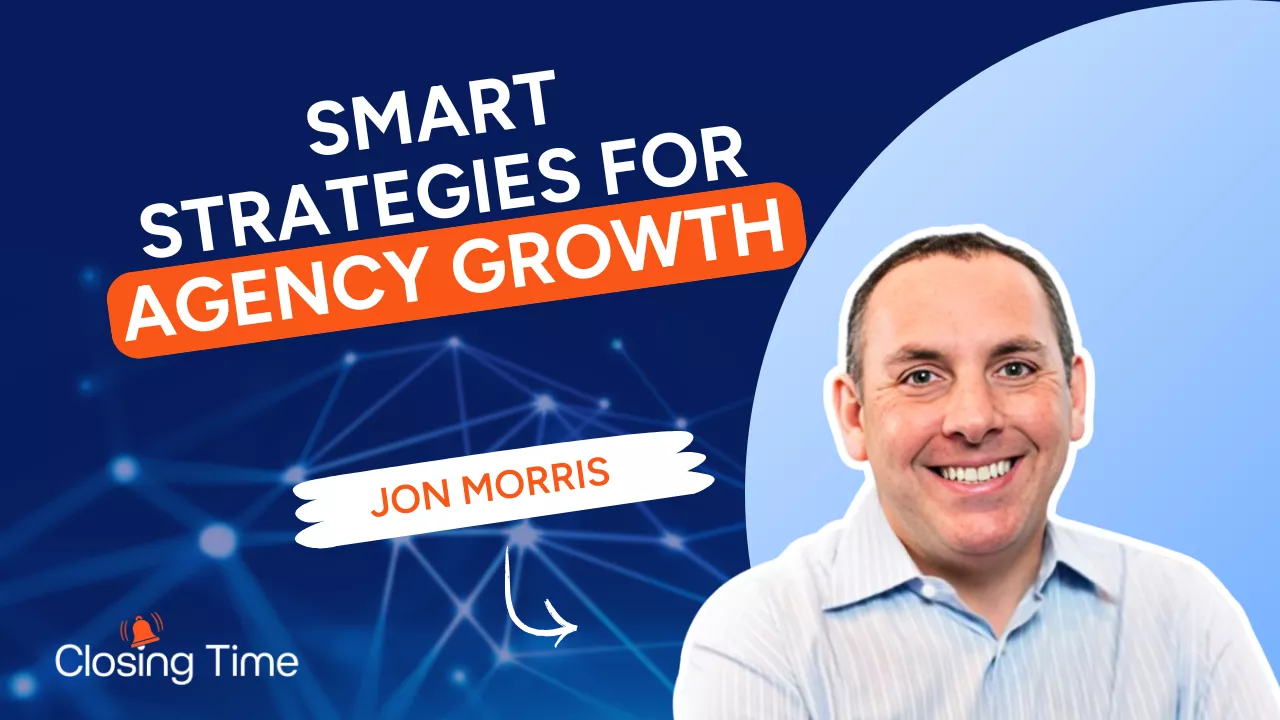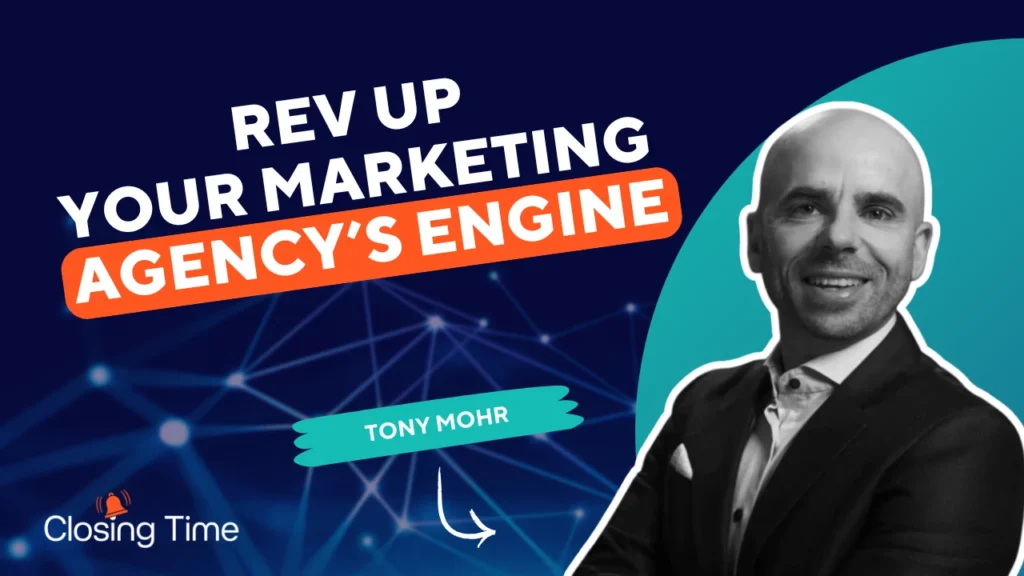What’s the best action to take
for your agency, given the uncertainty in the North American economy?
Let’s hear from an expert in today’s episode of Closing Time.
Thanks for tuning into Closing Time, the show for Go to Market Leaders.
I’m Val Riley, VP of marketing for Unbounce and Insightly.
Today I’m joined by Jon Morris.
He is founder of Fiscal Advocate, a tech enabled finance
and strategic planning company for professional services firms.
Jon, so glad to have you on the show. Val, great to be here.
Thank you so much for having me.
Jon, your company specializes in helping professional services
firms grow by consulting with them on their financial position.
And you work with a lot of marketing agencies, which is of particular interest
to our audience.
Tell me a little bit about how you got into this business.
So I actually used to own my own digital agency.
And I scaled it from just me to one of the largest independent
digital agencies in the United States and stepped down
during the pandemic and had three young daughters.
The world was closed.
I didn’t know what I was going to do,
and I had a business coach who kept on saying, you know, the insights
that you have is like, nothing I’ve ever seen it.
It’s a business within itself.
And so I decided to turn it into a business.
And so now what I do is I take financial data and I help
my clients make better decisions to help grow their businesses.
And that’s how it all got started.
So, you know, a lot of agencies, especially when they’re first
starting out, will go ahead and hire a bookkeeper.
But you’re talking about real financial planning and analysis.
Can you talk folks through what that difference might be?
Absolutely.
So when you think of the finance department, as you said,
a lot of companies really just think of it as bookkeeping or tax.
But there’s this whole department called financial planning analysis or FP&A,
and what they do is budgeting and forecasting, cash flow
analysis, resource planning, monthly insight.
And it’s all about how do you take financial data,
manipulate it so that you can make better decisions.
So let’s say you’re there’s an agency out there.
At what part of their life cycle do they typically reach out to someone like you?
I mean, probably not when they’re just getting out of the gate, right?
I mean, there’s value like from when you just get started.
But yes, typically I tell people when you’re at $5 million in revenue,
it’s time to start creating a financial planning analysis department.
And I would say by the time you’re at 10 million, you absolutely
should have a group that is providing really the insights
that are necessary to spend your time and your money much more intelligently.
Right. So?. So just like a therapist. Right?
People typically reach out when there’s a problem.
So you had mentioned, you know, if you’re having your agency is reached,
maybe a plateau stage, that might be a good time to talk to someone like you.
Why is that?
whether you are 10 million, 20 million, 50 million,
at some point, all of a sudden you’re no longer growing.
And it’s really amazing.
But I can go look at someone’s income statement
and after doing some manipulation, almost instantly tell you why that is the case.
Generally speaking, they’re not servicing their customers profitably enough.
They’re not spending enough in, sales and marketing.
They’re not spending money in innovation.
And and so what we do is we can really help solve that problem
of getting them back on to a growth trajectory
by spending once again their time and their money in a more intelligent
manner than what they’re currently doing.
I mean, I can’t imagine an agency wouldn’t want to speak with you.
So let’s say you’re brought into an agency.
What is the way you might, like, grade the health of the agency
once you’re in an engagement with them.
So there’s three major benchmarks. I look at are three major KPIs.
So the first one is how much cash they have relative to monthly overhead.
I like to use two examples, but the first example I like to use
is that Microsoft bought LinkedIn for $26.2
billion in an all cash deal.
If you have lots of cash, you have lots of optionality.
The other example I like to give is
imagine you walk into a drugstore and you want to buy a candy bar.
My instinct is
you do not spend any time thinking about the price of that candy bar.
If you want the king sized candy bar,
you’re going to go by the king sized candy bar.
Well, if you start storing a lot of money and build up your cash, candy bars
can become companies and it allows you to have a whole new growth methodology.
The second one is profit margin.
I want our clients to have a 20% EBITDA,
which means that 20% of their revenue is their profit.
And then the third one is. I want our clients
to grow at 20% on a year over year basis.
And those are the only three metrics that I really believe matter.
Now, there might be other metrics
that roll up to those metrics, but if you can have those three numbers
in those areas that I want them to be, then you have a healthy organization.
If you are not achieving one of those three metrics, then we have work to do.
so the classic rule of 40 is what I’m hearing, which is great.
Jon. When an agency is interested
in potentially partnering with or acquiring another agency.
Do you get involved in that process as well?
I do on an advisory capacity.
So I actually have a client right now that’s looking to buy a marketing agency.
And I’m involved in all aspects of the deal cycle.
What I really try to do, though, is help
them more shape the overarching strategy for their M&A strategy.
So what is their ideal client profile?
What services do they want to do internally and what services do
they want to buy?
Then from there, what size company are they looking to buy?
Is this team going to be folded into their leadership team,
or are they going to be add ons to an existing leadership team?
So I help with the overarching strategy.
But the other part is. I really have them start with
how much capital do you need, and how do you secure that capital
so that you can actually pursue this strategy?
One thing I’ve seen a lot recently,. Jon, is agencies choosing
to stay super narrow in what they offer,
and then partner with other agencies to serve clients that have needs that
cross that, that are beyond what their particular agency offers.
Is that a trend that you’re seeing that rather than agencies growing exponentially
and offering all types of services, that they really lean into a certain area
and then partner with other agencies
when they have a client that they want to serve.
Yes. And,. I’m going to talk about agencies,
and I talk about service providers in general.
There are 120,000 agencies just in the United States,
and it is a crowded space.
No matter who you are and no matter what you do,
you have hundreds, if not thousands of competitors.
So what’s happening is, because it is such a crowded space,
it’s you’re getting a lot of specialization now.
You’re getting specialization in terms of going after specific verticals,
and you’re also getting specialized action in terms of, of,
you know, not trying to go a mile wide, an inch deep, or go an inch wide
and a mile deep.
And I think it’s the right strategy.
But you also need to know when is it
time to expand, whether it’s time to expand on the next vertical
or when is it time to expand to, the next service offering?
And the reason why is, there can be disruption, you know, like,
if you just look at AI coming out, there could be disruption to your service.
So you don’t want to get stuck flatfooted.
And so you do have to think about that diversification strategy.
Got it.
So let’s go back towards growth a little bit.
In your opinion, what percentage.
You know the it’s it’s the old adage the the cobbler’s kids have holes
in their shoes.
So what percentage of revenue
should agencies be spending on their own promotion.
Yeah. So the average is 8%.
So, when I was running Rise, my last agency,
I would meet with a lot of agency owners that wanted to grow at the same speed
that Rise was growing.
They would always ask me, you know, what was my secret?
And I would ask them, what, what percent of your revenue do you spend on
sales and marketing and like, oh, it’s all just word of mouth.
And, you know, so my answer was, how come I’m
the only marketer that actually believes in marketing?
And so if you think about the average is 8%,
that means half are above 8% and half are below 8%.
I want my clients to spend between 12
and 15% of their revenue on sales and marketing.
I don’t want them to be the best kept secret.
I want them to be known
as the best brand for their specific niche that they’re going after.
Yeah. I love the litmus test you had.
You said there’s, there are some things that your agency must be doing.
Some things that you probably shouldn’t be doing.
And then.
But you should always have a few tests running in the hopper. Yep.
So exactly as you just said.
So what I think about is playbooks.
So my job it’s weird.
I help people with their finances,
but at the same time I bring playbooks that they should be investing in.
And so when it comes to sales and marketing, there are certain playbooks
that I know work and that you should absolutely do them.
I also know that there are playbooks that don’t work.
You know that I have enough data points not just from my own experience, but
from all my clients, and you shouldn’t be doing them.
And then there are playbooks that are worthy of testing.
And, you know, and if you don’t spend money
on that testing, you’re never going to break through.
You know, one of the big mistakes people make is, you know,
I do all their budgeting and their forecasting and they’re like,
we’re going to go hire a sales person.
So therefore we’re going to double
the amount of new business that we’re going to get from sales,
or we’re going to launch this new media campaign,
but we’ve never launched it before,
but I’m going to double the amount. I’m going to win for of new business.
And when I explain is the challenge with testing is until you gather enough data,
you really don’t know if it’s going to work or not.
And so what you’re looking for is that breakthrough idea,
and you got to measure it, make sure it’s working.
And then if it does work then you add, you know,
fuel to the fire and go all in on that strategy.
Yeah. Makes sense.
Jon, the one thing you can say about the North
American markets right now is that they are a little destabilized.
And it seems to change every day.
So, what are you telling your clients in professional services
and then specifically the marketing agency clients
that you have on on ways they can weather this very strange time.
Yeah.
So when the ground is not stable, what you have to think about
is the math changes and it doesn’t change in your favor.
And what I mean by that is
when it comes to winning new business, there’s only four metrics that matter.
How many At-Bats or how many opportunities are you generating?
What is your win rate?
What is the average order value, and then what is the sales cycle?
And so what you
might find is pressure on one of those four metrics.
You know.
So for example, one of the things. I’ve been seeing with my own business
as well as, several my client is the sales cycle is extended.
And so that means that whatever your strategy was for the year,
that you are going to really have to think about,
that you might not achieve your new business goal.
So I generally recommend a defensive strategy
and an offensive strategy to help you with that.
Going into the defensive strategy,. I want you to really tighten the belt.
I want you to be less revenue growth focused.
I want you to be more profit focused.
The second thing is, I,
I want you to freeze open roles.
I want you to, communicate
with your team about what’s happening, what the expectations are.
But I really want you to.
To preserve your cash
and really make sure that you’re not in a bad shape should things get worse.
That being said,
if you just do that, well, then you’re definitely not going to grow.
And so you need to have an offensive strategy that goes along with it.
And so the first thing. I like to think about is,
generally speaking, everybody takes a defensive strategy.
And so it’s kind of like dancing.
Like if everyone takes a step back
you get an opportunity to take a step forward.
And so if you could think about how you can actually increase your sales
and marketing during that time period, you actually be able to gain market share.
So here are the few strategies. I recommend.
The first thing is,. I really want you to focus on
how do you leverage your time throughout the entire organization
towards more sales and marketing efforts.
So let’s start attending more networking events.
Let’s go focus on owned and earned media.
So we don’t want to go spend money on paid media
because we’re trying to tighten the belt.
But owned and earned media might be a really good strategy.
You might increase all of your content marketing.
You might get the whole organization to help you with blog writing.
The other thing is, as I talked about
one of the metrics is average order value decreases.
This is surprisingly an opportunity
to start going up marketing go towards larger companies
because what they’re going to be looking to do is tighten their belt.
And so they might renegotiate with their existing providers
or say, you know what, these providers are too expensive.
Let me go with a smaller company.
And so this is actually an opportunity where you can get larger clients because
they’re actually looking to go downstream as you’re looking to go upmarket.
So I love the offense and defensive approach is basically you’re saying,
hey, in terms of, on the offensive side, what can we do without cash?
Right?
Like, what are the strategies that don’t involve cash?
How is that received from by your client base?
Because that feel they can feel a little bit tricky.
if something’s important to you, you got a budget for it.
What I’m saying is budget time. Right.
And so I’m, I’m asking
your whole organization to lean in
and understand that they’re going to have to do more.
So on the defensive side, if you’re freezing open roles,
that means that your existing team might have to work more.
But on the offensive side,
you know, you’re asking people to go to a networking event.
You’re asking them to write content for you.
You’re ask them to do all these things.
It generally resonates well,
but you have to have the right culture within the company.
You know, if your employees are not all in on this strategy,
it’s going to be hard because we’re asking not just like the owner, to do this.
We’re asking the organization
to do this and help everyone get out of this situation.
I always feel that same, pressure.
We always tell our team members, hey, we spend a lot of money on LinkedIn ads,
but if everyone in the organization would just repost some things
that we’re putting out there, our reach would be literally exponential.
So there are some things that folks can do that don’t cost anything that really do
bring the move the organization forward.
So some parting thoughts, Jon, if you could tell agencies one message
right now, given
what’s going on all these uncertain times, what would that message be?
This can be emotionally tough time.
And, you know what?
Like, this is the time that you need to double down
and work harder to get yourself through this time.
But know that you’re not alone.
You know,. I can’t tell you how many therapy sessions
I’ve had with clients over the last month because they’ve been struggling.
The second thing is,
have a profit-first focus,
but leverage all of your assets to go all in
on the owned and earned media side so that you can get the pipeline
going and get yourself through these uncertain times.
Sounds great.
Jon, if our audience wants to follow you or learn more about your firm,
where should we send them?
So I post regularly on LinkedIn, so please follow me on, on LinkedIn.
You can also go to Fiscaladvocate.com to learn more about who we are
and what we do.
And lastly,. I love building relationships with people.
Email me at [email protected].. Perfect.
Thanks, Jon.
And thanks to all of you for tuning in to Closing Time.
Remember, you can get this episode delivered right to your inbox.
Just click the link in the show notes and we will see you next week.




